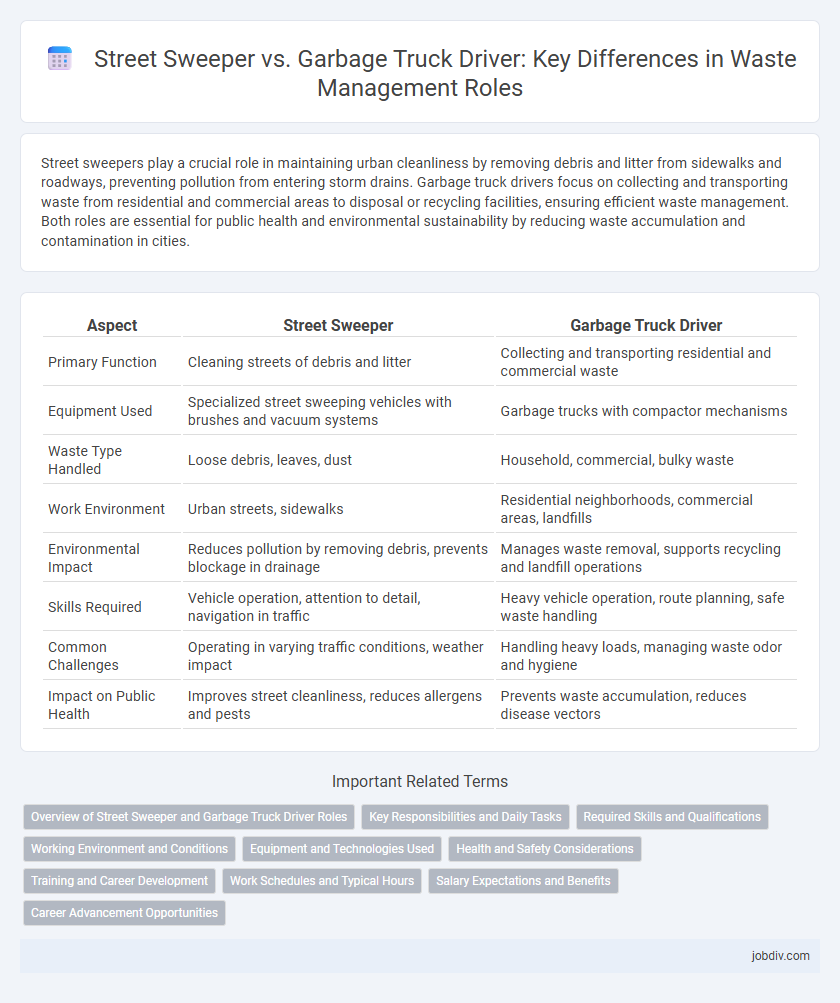Street sweepers play a crucial role in maintaining urban cleanliness by removing debris and litter from sidewalks and roadways, preventing pollution from entering storm drains. Garbage truck drivers focus on collecting and transporting waste from residential and commercial areas to disposal or recycling facilities, ensuring efficient waste management. Both roles are essential for public health and environmental sustainability by reducing waste accumulation and contamination in cities.
Table of Comparison
| Aspect | Street Sweeper | Garbage Truck Driver |
|---|---|---|
| Primary Function | Cleaning streets of debris and litter | Collecting and transporting residential and commercial waste |
| Equipment Used | Specialized street sweeping vehicles with brushes and vacuum systems | Garbage trucks with compactor mechanisms |
| Waste Type Handled | Loose debris, leaves, dust | Household, commercial, bulky waste |
| Work Environment | Urban streets, sidewalks | Residential neighborhoods, commercial areas, landfills |
| Environmental Impact | Reduces pollution by removing debris, prevents blockage in drainage | Manages waste removal, supports recycling and landfill operations |
| Skills Required | Vehicle operation, attention to detail, navigation in traffic | Heavy vehicle operation, route planning, safe waste handling |
| Common Challenges | Operating in varying traffic conditions, weather impact | Handling heavy loads, managing waste odor and hygiene |
| Impact on Public Health | Improves street cleanliness, reduces allergens and pests | Prevents waste accumulation, reduces disease vectors |
Overview of Street Sweeper and Garbage Truck Driver Roles
Street sweepers operate specialized vehicles designed to clean streets by removing debris, dirt, and litter to maintain urban cleanliness and prevent pollution. Garbage truck drivers handle the collection and transportation of household and commercial waste to disposal or recycling facilities, ensuring proper waste management and sanitation. Both roles are crucial for maintaining public hygiene, with street sweepers focusing on surface cleanliness and garbage truck drivers managing waste removal.
Key Responsibilities and Daily Tasks
Street sweepers are responsible for cleaning streets by operating specialized vehicles equipped with brushes and vacuum systems to remove debris, leaves, and litter, ensuring public spaces remain clean and safe. Garbage truck drivers focus on collecting residential and commercial waste, operating large refuse vehicles, lifting and emptying trash bins, and maintaining routes to ensure timely waste disposal. Both roles require adherence to safety protocols, maintenance of vehicles, and coordination with waste management teams to optimize urban cleanliness and sanitation.
Required Skills and Qualifications
Street sweepers require strong attention to detail, effective machine operation skills, and knowledge of urban traffic patterns to safely and efficiently clean streets. Garbage truck drivers need a commercial driver's license (CDL), physical strength to handle heavy waste containers, and excellent time management to maintain collection schedules. Both roles demand a commitment to safety protocols and environmental regulations to ensure public sanitation standards are met.
Working Environment and Conditions
Street sweepers operate in dynamic urban environments, often exposed to dust, noise, and traffic hazards while maintaining city cleanliness. Garbage truck drivers work in demanding conditions involving heavy lifting, tight schedules, and varying weather, navigating residential and commercial areas to collect waste. Both roles require physical endurance and attentiveness to safety protocols to manage occupational risks effectively.
Equipment and Technologies Used
Street sweepers utilize advanced brushes, vacuum systems, and water jets to effectively remove debris and dust from road surfaces, enhancing urban cleanliness. Garbage truck drivers operate vehicles equipped with hydraulic lifts, compactors, and GPS routing systems to efficiently collect and transport residential and commercial waste. Both rely on evolving technologies to optimize waste management, reduce emissions, and improve operational efficiency in urban environments.
Health and Safety Considerations
Street sweepers and garbage truck drivers face distinct health and safety risks linked to their roles in waste management. Street sweepers are exposed to airborne dust, traffic hazards, and repetitive strain injuries, requiring protective equipment and ergonomic tools to minimize respiratory issues and musculoskeletal disorders. Garbage truck drivers encounter risks from heavy lifting, vehicle accidents, and exposure to biohazardous waste, necessitating rigorous training, proper lifting techniques, and personal protective gear to ensure occupational safety.
Training and Career Development
Street sweeper operators undergo specialized training focused on maneuvering compact vehicles and mastering debris collection techniques in urban environments. Garbage truck drivers receive extensive instruction in heavy vehicle operation, waste sorting protocols, and safety regulations to handle varied refuse loads efficiently. Career development for both roles includes opportunities for advanced certifications, supervisory positions, and transitioning into broader waste management or environmental services sectors.
Work Schedules and Typical Hours
Street sweepers usually work during early morning or overnight shifts, often clocking 6 to 8 hours to avoid traffic congestion and maintain clean streets. Garbage truck drivers typically have longer shifts of 8 to 10 hours, starting early in the morning to efficiently cover large collection routes. Work schedules for both roles can include weekends and holidays, but garbage truck drivers often face more physically demanding and time-sensitive routes.
Salary Expectations and Benefits
Street sweepers earn an average annual salary between $30,000 and $45,000, while garbage truck drivers typically have higher pay ranging from $40,000 to $60,000 due to increased job demands and responsibilities. Benefits for both roles often include health insurance, retirement plans, and paid time off, with garbage truck drivers sometimes receiving additional overtime pay and hazard bonuses. Job stability and union membership opportunities tend to be stronger for garbage truck drivers, contributing to enhanced long-term benefits and career growth.
Career Advancement Opportunities
Street sweepers typically have limited career advancement opportunities, often remaining in operational roles with occasional chances to move into supervisory positions. Garbage truck drivers, on the other hand, may advance into logistics management, fleet supervision, or waste management coordination roles due to the broader scope of their responsibilities. Experience in waste collection operations increasingly opens pathways to higher-level positions within municipal or private waste management companies.
Street Sweeper vs Garbage Truck Driver Infographic

 jobdiv.com
jobdiv.com